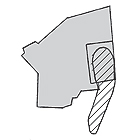First Temple Period, 1000-586 BCE
|

|
Jerusalem was the capital of the kingdom in the First Temple period. During this period the city expanded to the north and included the City of David, which was already inhabited in the previous period, the area north of the City of David (called the Millo or the Ophel) where the center of government was situated including its buildings and palaces, and the high hill of the Temple Mount. Later, probably during Hezekiah's reign, the 'Western City', which is the Upper City, was included within the area of the city.
Finds:
Sections of the eastern wall from the First Temple period are in the City of David. These were built midway up the slope, above the Nahal Kidron channel, together with residential buildings. Sections of the northern line of fortifications still exist and consist of a wall and towers, some of which were used as a foundation for the fortifications from the Hasmonean period. Sections of the 'Broad Wall' from the time of Hezekiah and Menasha (end of the eighth century and the middle of the seventh century BCE), which belong to the fortifications that encircled the western hill before the destruction of the First Temple in 586 BCE, were discovered in Nahum Avigad's excavations in the Jewish Quarter.
Historical Sources:
Book of Samuel II (5:6-9), Chronicles I (11:4-8)
"…And David and all Israel went to Jerusalem, that is Jebus, where the Jebusites were, the inhabitants of the land. The inhabitants of Jebus said to David, "You will not come in here." Nevertheless David took the stronghold of Zion, that is, the city of David. David said, "Whoever shall smite the Jebusites first shall be chief and commander." And Joab the son of Zeruiah went up first so he became chief. And David dwelt in the stronghold; therefore it was called the city of David. And he built the city round about from the Millo in a complete circuit; and Joab repaired the rest of the city…" (I Chronicles 11:4-8)
Remarks:
At the time of the kings of Judah the city also included the water system that is known as Warren's Shaft. A number of alternatives have been proposed for the route that the walls followed, which included the 'Western City' during the reign of the kings of Judah (see M. Ben-Dov 1983, p. 27 for a comprehensive explanation).
|
|

| The city in the First Temple period |
|















